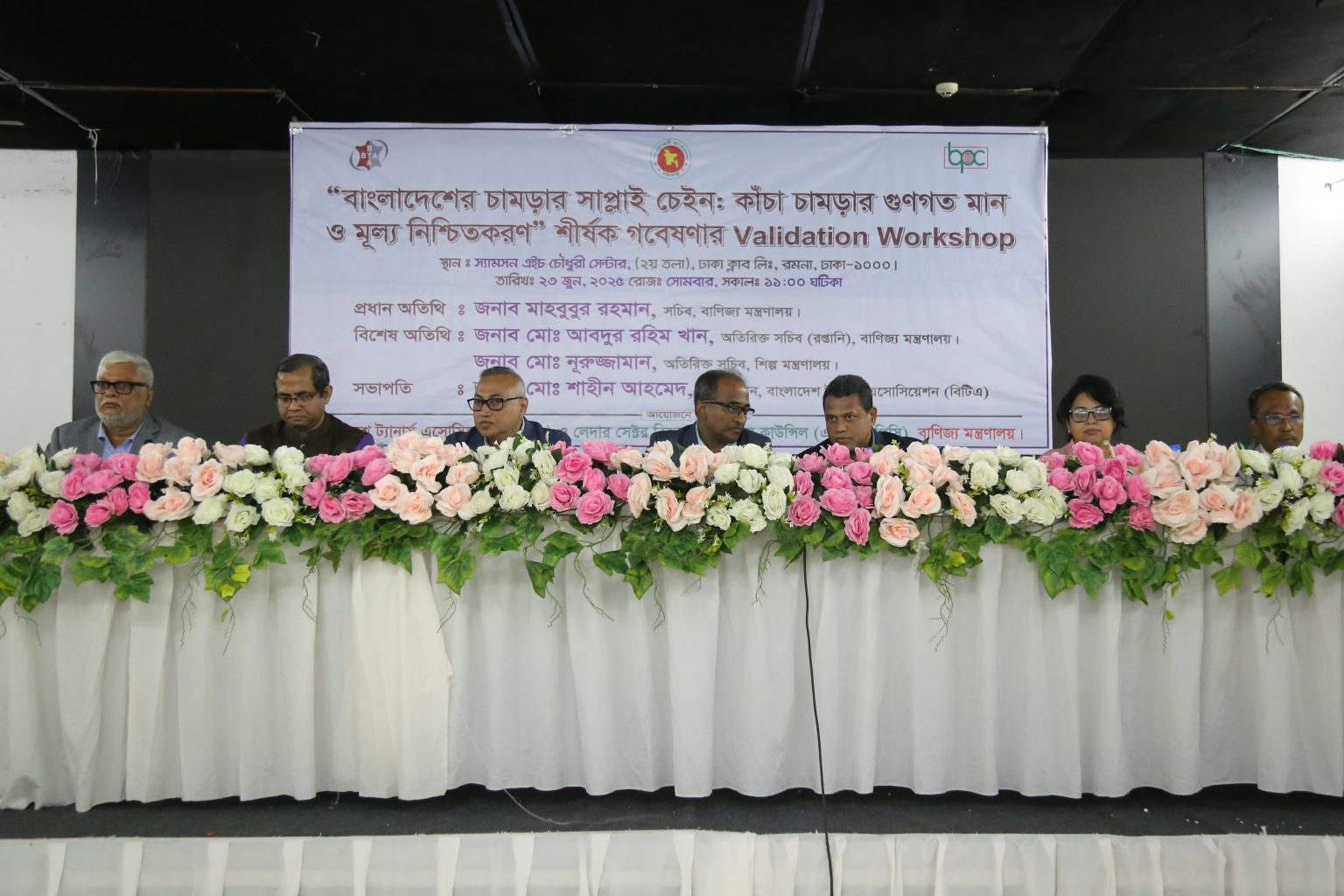At a workshop titled “Bangladesh’s Leather Supply Chain” organised by Bangladesh Tanners Association (BTA) and Leather Sector Business Promotion Council (LSBPC) at Samson H Chowdhury Center in Ramna on Monday, industry leaders revealed alarming inefficiencies in the country’s leather sector.
BTA member Mahbubur Rahman highlighted how the 2017 relocation of tanneries from Hazaribagh to Savar continues to disrupt production, emphasising the need to better understand global demand patterns versus domestic leather utilisation.
A comprehensive post-Eid survey across five key districts (Dhaka, Barishal, Chattogram, Natore, and Mymensingh) exposed critical weaknesses in the supply chain. The study of 768 cases found only 5% of sacrificial animals were slaughtered by professionals, while 21% of hides suffered from improper “flow cut” techniques.
Shockingly, 98% of collected hides contained stains, with 68% showing cuts, 23% heat damage, and 18% rot – revealing massive quality deterioration at collection points.
Tamim Ahmed identified stringent LWG (Leather Working Group) standards as a major price depressant while disputing government livestock data. He stressed how the absence of modern slaughterhouses continues to compromise hide quality, though he noted some improvement with reduced sectoral extortion this year.
His proposals included implementing biannual surveys, introducing mobile slaughter services, expanding tannery operations beyond Dhaka, and promoting university-led research initiatives to address technical gaps.
BTA President Shaheen Ahmed presented sobering export realities, noting that despite utilising 30% of available hides, Bangladesh captures just $1 billion of the $450 billion global leather market.
He called for establishing a specialised committee to streamline complex processes, adopting institutionalised preservation methods, and implementing workplace reforms to attract younger professionals to the sector.
Commerce Ministry Additional Secretary Abdur Rahim Khan directly linked price drops to quality deterioration, assuring government commitment to infrastructure development.
CPD Research Director Dr Khondkar Golam Moazzem pushed for formalising supply chains, setting minimum raw hide prices during Eid, and conducting accurate animal censuses to stabilise the market.
Executive committee members outlined operational imperatives, including proper valuation of hides while still on livestock, promoting domestic leather usage, establishing district-level slaughterhouses, and training stakeholders in proper salt utilisation techniques.
The workshop, attended by researchers and government officials including Industries Ministry Additional Secretary Md Nuruzzaman, concluded with consensus on the urgent need for systemic reforms to revive this promising sector.
Poor management crippling country’s leather sector
At a workshop titled “Bangladesh’s Leather Supply Chain” organised by Bangladesh Tanners Association (BTA) and Leather Sector Business Promotion Council (LSBPC) at Samson H Chowdhury Center in Ramna on Monday, industry leaders revealed alarming inefficiencies in the country’s leather sector.
BTA member Mahbubur Rahman highlighted how the 2017 relocation of tanneries from Hazaribagh to Savar continues to disrupt production, emphasising the need to better understand global demand patterns versus domestic leather utilisation.
A comprehensive post-Eid survey across five key districts (Dhaka, Barishal, Chattogram, Natore, and Mymensingh) exposed critical weaknesses in the supply chain. The study of 768 cases found only 5% of sacrificial animals were slaughtered by professionals, while 21% of hides suffered from improper “flow cut” techniques.
Shockingly, 98% of collected hides contained stains, with 68% showing cuts, 23% heat damage, and 18% rot – revealing massive quality deterioration at collection points.
Tamim Ahmed identified stringent LWG (Leather Working Group) standards as a major price depressant while disputing government livestock data. He stressed how the absence of modern slaughterhouses continues to compromise hide quality, though he noted some improvement with reduced sectoral extortion this year.
His proposals included implementing biannual surveys, introducing mobile slaughter services, expanding tannery operations beyond Dhaka, and promoting university-led research initiatives to address technical gaps.
BTA President Shaheen Ahmed presented sobering export realities, noting that despite utilising 30% of available hides, Bangladesh captures just $1 billion of the $450 billion global leather market.
He called for establishing a specialised committee to streamline complex processes, adopting institutionalised preservation methods, and implementing workplace reforms to attract younger professionals to the sector.
Commerce Ministry Additional Secretary Abdur Rahim Khan directly linked price drops to quality deterioration, assuring government commitment to infrastructure development.
CPD Research Director Dr Khondkar Golam Moazzem pushed for formalising supply chains, setting minimum raw hide prices during Eid, and conducting accurate animal censuses to stabilise the market.
Executive committee members outlined operational imperatives, including proper valuation of hides while still on livestock, promoting domestic leather usage, establishing district-level slaughterhouses, and training stakeholders in proper salt utilisation techniques.
The workshop, attended by researchers and government officials including Industries Ministry Additional Secretary Md Nuruzzaman, concluded with consensus on the urgent need for systemic reforms to revive this promising sector.


